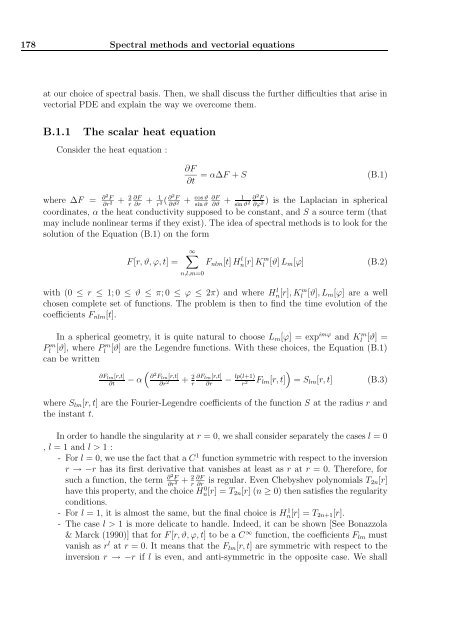Ecole doctorale de Physique de la région Parisienne (ED107)
Ecole doctorale de Physique de la région Parisienne (ED107)
Ecole doctorale de Physique de la région Parisienne (ED107)
Create successful ePaper yourself
Turn your PDF publications into a flip-book with our unique Google optimized e-Paper software.
178 Spectral methods and vectorial equations<br />
at our choice of spectral basis. Then, we shall discuss the further difficulties that arise in<br />
vectorial PDE and exp<strong>la</strong>in the way we overcome them.<br />
B.1.1 The sca<strong>la</strong>r heat equation<br />
Consi<strong>de</strong>r the heat equation :<br />
∂F<br />
∂t<br />
= α∆F + S (B.1)<br />
where ∆F = ∂2F ∂r2 + 2 ∂F 1 + r ∂r r2 ( ∂2F ∂ϑ2 cos ϑ ∂F 1<br />
+ + sin ϑ ∂ϑ sin ϑ2 ∂2F ∂ϕ2 ) is the Lap<strong>la</strong>cian in spherical<br />
coordinates, α the heat conductivity supposed to be constant, and S a source term (that<br />
may inclu<strong>de</strong> nonlinear terms if they exist). The i<strong>de</strong>a of spectral methods is to look for the<br />
solution of the Equation (B.1) on the form<br />
F [r, ϑ, ϕ, t] =<br />
∞<br />
n,l,m=0<br />
Fnlm[t] H l n[r] K m l [ϑ] Lm[ϕ] (B.2)<br />
with (0 ≤ r ≤ 1; 0 ≤ ϑ ≤ π; 0 ≤ ϕ ≤ 2π) and where H l n[r], K m l [ϑ], Lm[ϕ] are a well<br />
chosen complete set of functions. The problem is then to find the time evolution of the<br />
coefficients Fnlm[t].<br />
In a spherical geometry, it is quite natural to choose Lm[ϕ] = expimϕ and Km l [ϑ] =<br />
P m<br />
l [ϑ], where P m<br />
l [ϑ] are the Legendre functions. With these choices, the Equation (B.1)<br />
can be written<br />
∂Flm[r,t]<br />
∂t<br />
<br />
∂2Flm[r,t] − α ∂r2 + 2 ∂Flm[r,t]<br />
r ∂r<br />
lp(l+1)<br />
−<br />
r 2<br />
<br />
Flm[r, t] = Slm[r, t] (B.3)<br />
where Slm[r, t] are the Fourier-Legendre coefficients of the function S at the radius r and<br />
the instant t.<br />
In or<strong>de</strong>r to handle the singu<strong>la</strong>rity at r = 0, we shall consi<strong>de</strong>r separately the cases l = 0<br />
, l = 1 and l > 1 :<br />
- For l = 0, we use the fact that a C 1 function symmetric with respect to the inversion<br />
r → −r has its first <strong>de</strong>rivative that vanishes at least as r at r = 0. Therefore, for<br />
such a function, the term ∂2F ∂r2 + 2 ∂F is regu<strong>la</strong>r. Even Chebyshev polynomials T2n[r]<br />
r ∂r<br />
have this property, and the choice H 0 n[r] = T2n[r] (n ≥ 0) then satisfies the regu<strong>la</strong>rity<br />
conditions.<br />
- For l = 1, it is almost the same, but the final choice is H 1 n[r] = T2n+1[r].<br />
- The case l > 1 is more <strong>de</strong>licate to handle. In<strong>de</strong>ed, it can be shown [See Bonazzo<strong>la</strong><br />
& Marck (1990)] that for F [r, ϑ, ϕ, t] to be a C ∞ function, the coefficients Flm must<br />
vanish as rl at r = 0. It means that the Flm[r, t] are symmetric with respect to the<br />
inversion r → −r if l is even, and anti-symmetric in the opposite case. We shall
















